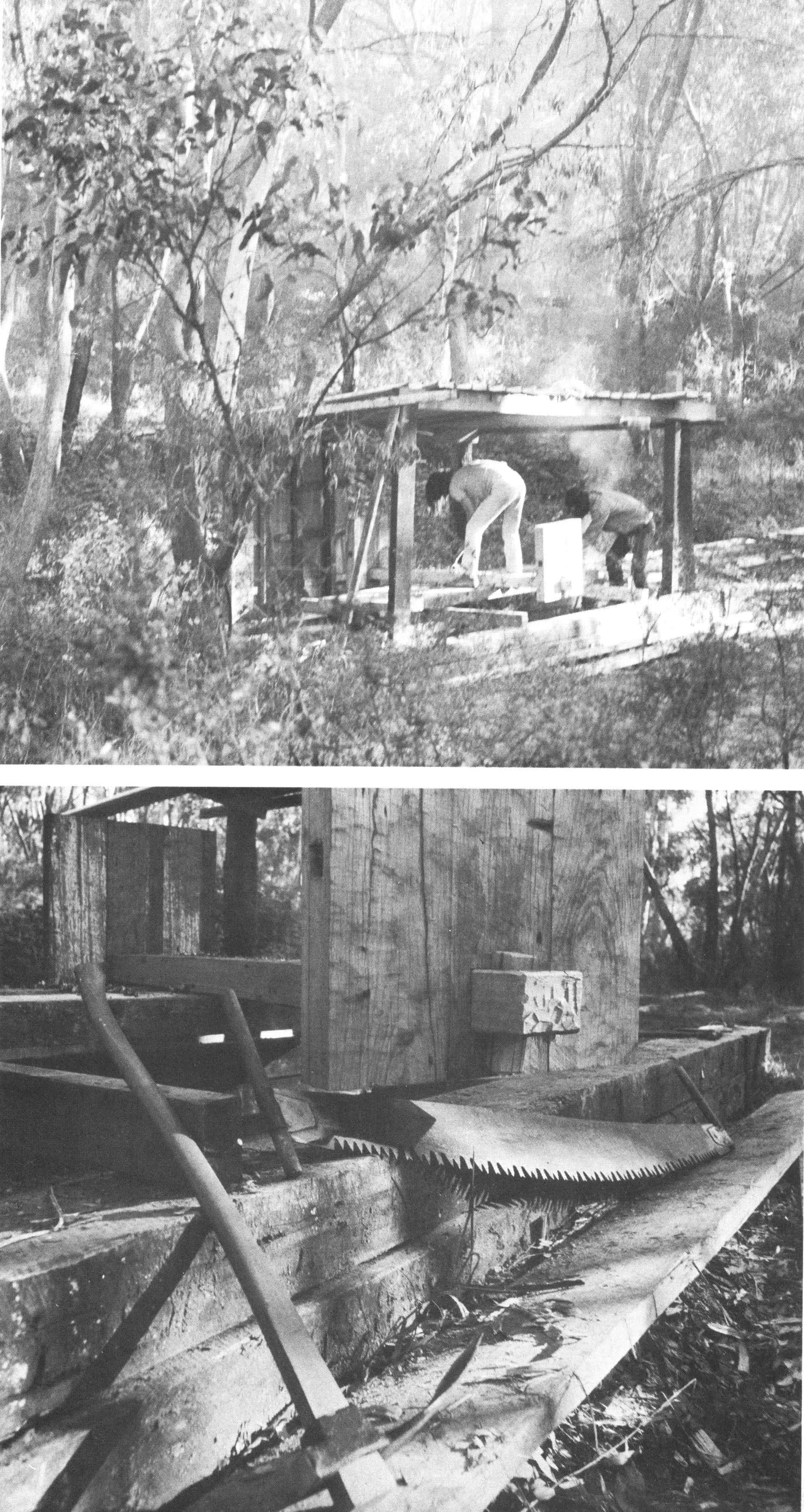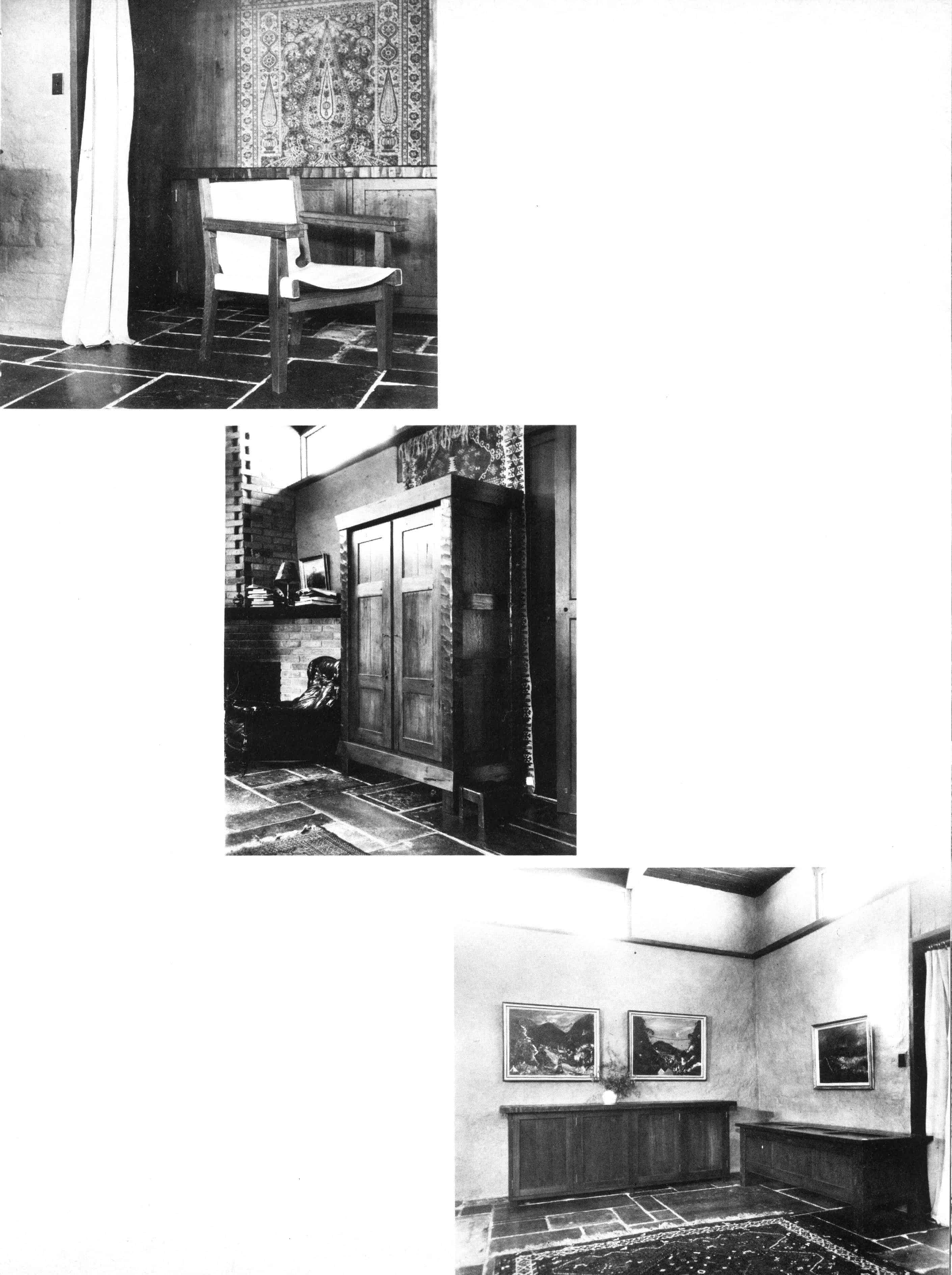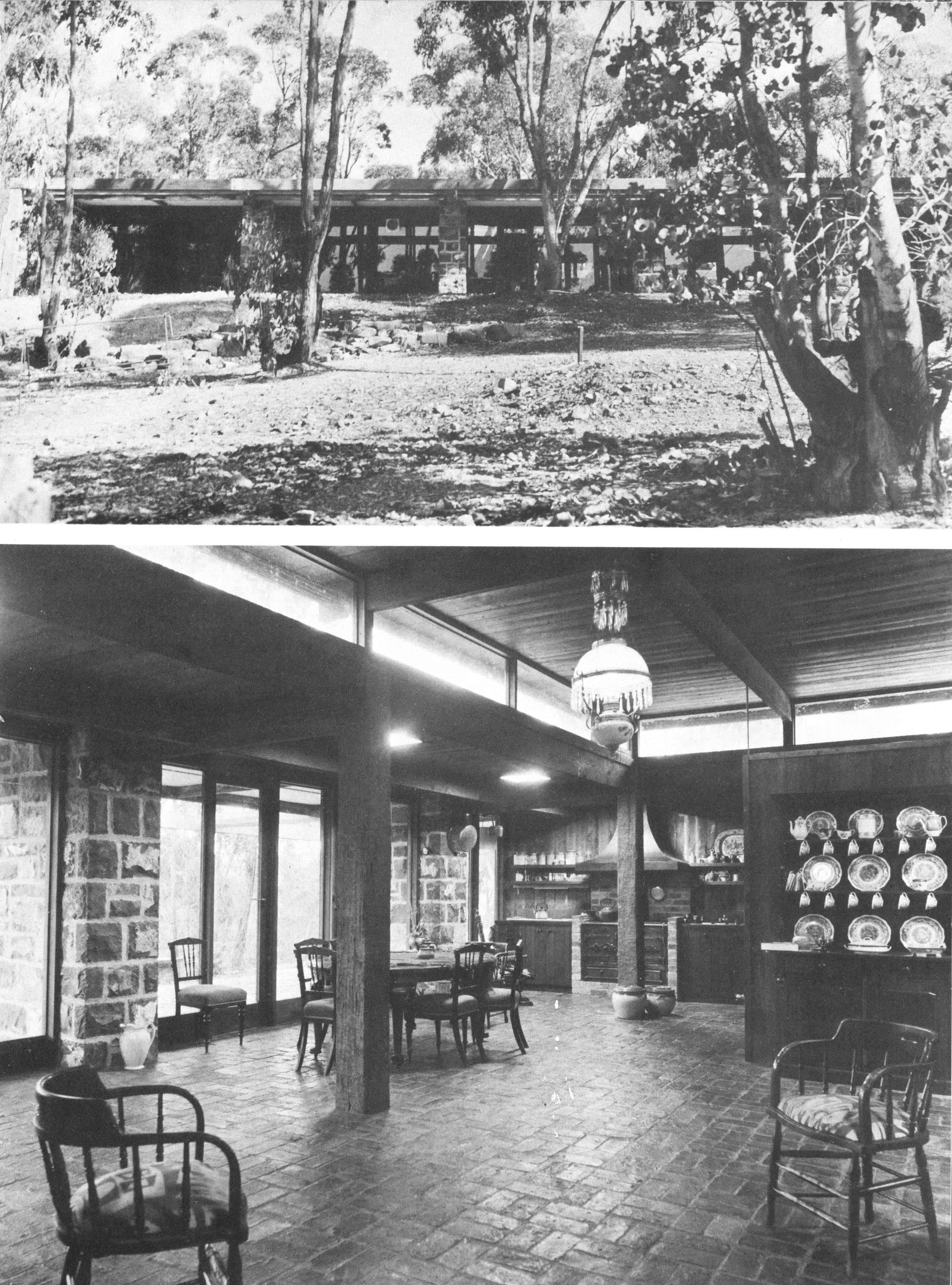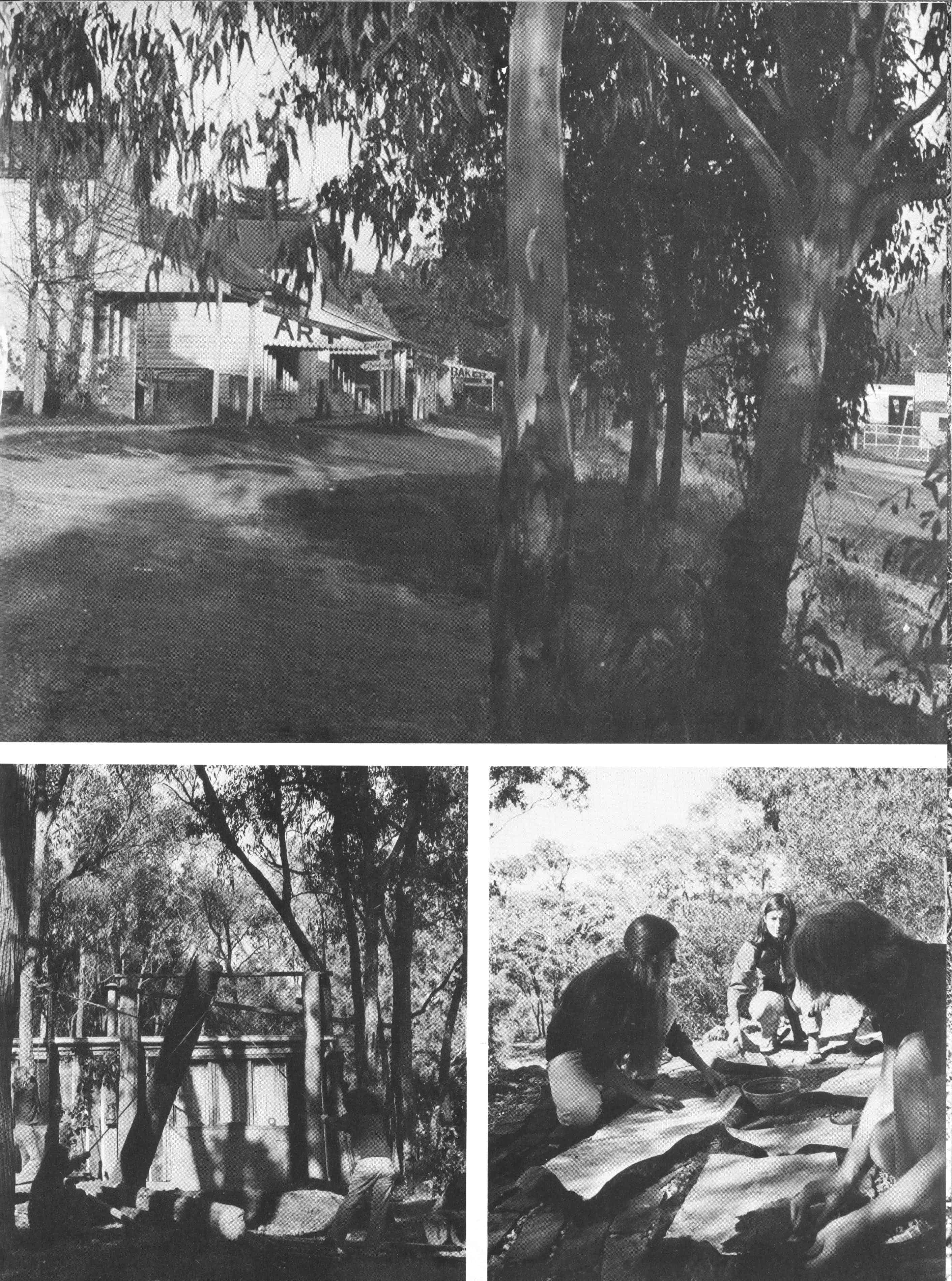Living in the Environment, Alternative Lifestyles
Alternative Lifestyles
Author: Alistair Knox
When my son Hamish and his friend John decided to make some adzed pioneer tables, they found that if they worked industriously the demand could provide them with an interesting lifestyle, a good income, and flexibility of daily living. Their work and their homes were next to each other. Their materials were simple and could be obtained at the local store or the second hand yard. Where timber getting is a tradition in the family, their skills were instinctive. Some discretion as to design and proportion and a normal and healthy body were all they required. The fruit of their labours are indestructible objects such as tables and benches up to twelve feet in length made from the sunburnt red and white hardwoods of Australia. These are traditions indigenous to our land. The use of alien softwood is strictly out. The three and four inches thick timber is always second hand from some ancient demolished building. The use of simple tools such as the adze and the crosscut saw gives this craft an aura that always attracts an audience.
Hamish and John set up a shelter on some land we owned adjacent to our property by nailing some battens to two trees and providing support in front and erecting corrugated iron. They did not have electrical power. A petrol driven saw was purchased that complainingly cuts through the old sections that need reshaping. They christened it the 'red rooster' and it gives off a comforting old fashioned choof choof choof when it starts up, to recall another way of life in another age. These noises come from a winding track that disappears into the bush. At the gate a sign points along it bearing the inscription 'Cape Lambert'. This Cape Lambert sign is a memento that Hamish brought back from a place of that name on the north west coast of West Australia where he worked for a few months immediately after he left school. His job was to use a jack hammer for drilling and placing explosives to assist the powder monkeys in vast explosions for iron ore. He lived with some six thousand men of different colours and nations and saw first hand how people outside his own community acted and thought.
All his school life had been within walking distance of his home and he was able to contrast the two ways of life realistically. He was able to draw cohesive conclusions as to how it should affect him. It is a climate which should be the automatic right of every Australian. The pushing and shoving that Australian society exerts to get their offspring through some university course to perpetuate the money game, so often prevents otherwise protected and privileged groups from experiencing it.
 Above top: Hamish and John in their 'Cape Lambert' factory.
Above bottom: The tools of trade of the furniture maker
Above top: Hamish and John in their 'Cape Lambert' factory.
Above bottom: The tools of trade of the furniture maker
One of the consistent hazards of the 'do it yourself' university is that it attracts other people and causes a cessation of work to enjoy the time of the day or to merely stand and stare. This rare quality is also one of the richest gifts we can receive in today's society. It is the direct opposite of the 'future shock' victims. Here you belong to a time and a place indefinitely. In fact you yourself are making both that time and that place. It is always stimulating to drive past that bend in the road where that feather of smoke is ascending out of the bush screen. You know that behind those trees a billy is coming to the boil and four or five grubby cups are being swilled out in preparation for a tea ceremony and a permanent conversation piece concerning land rovers and motor cycles. Here the thoughts and dreams of youth - those long, long dreams and thoughts are expounding the visions and hopes of the new generation. A location in the natural environment gives a quality essential to stable dreams and non-violent proposals. It goes with the understanding of the power of nature and the spiritual qualities of the total man. It is a climate where we see things whole and see them clear.
In a place like Eltham the alternative society encounters little problem until its participants marry. Then it becomes a struggle to set up house and retain the liberties of an outside life and the choice of working or of just looking, whichever you feel like. So often the pressures of respectability and babies tend to draw the male back to some factory or builder's labourer's job and the young dreams are gradually extinguished. The adventurous and liberty seekers are in danger of becoming numbered. They have sinned against the embalmed society and must suffer for it. The pale faced students and sons of the rich have languished in university ghettos while the fearless urchins of the alternative society have sung and danced. They deserve their 'come uppins' whatever they might bring. They can't have it both ways. There must be a catch in their protests that they want less for more.
Many wise minds are being exercised by the aim to build a stable co-existing society within the framework of the existing one, but without becoming engulfed by it. It will mean a grafting on process which takes sap from the parent tree without inheriting its dead wood. It should set up good communications with the privileged who so often, despite their stiff upper lip, are pretty bewildered by the collapsing order around them. It will find much more support there than it imagines. It must restrain its indulgence of thumbing- noses at the establishment because it may prove to be the means of the alternative society's livelihood in the end. Many of the children of the embalmed community know there is not much future in that direction. Desperate efforts now have to be made to place graduates. The increasing competition for the strictly chosen opportunities of the recently all powerful corporation doesn't provide the comfort and consolation for the 'Bertie Wooster' group that once used to hoof and haw their way around the nightclubs. There is an ever-increasing preoccupation with the means of financial manipulations that keep the moneyed classes uppermost. But the one world one answer climate now rises up to the 'seventeenth floor of their aluminium and glass buildings and seeps into tneir very director's boardrooms. At the same time the perpetual smog of their well controlled activities pours its blanket of sulphur dioxide carbon monoxide, carbonblack, and all the other by-products of the present GNP scene over city and suburb indiscriminately.
 Examples of furniture designed by Alistair Knox . Top: Jarrah and hide stockman's chair with extending arms. Centre: Red ironbark ambry 6' 8" x 4' x 2'.
Bottom: Jarrah sideboard 8' x 2' x 3' and red gum linen chest 7'6" x 2' x 2'4"
Examples of furniture designed by Alistair Knox . Top: Jarrah and hide stockman's chair with extending arms. Centre: Red ironbark ambry 6' 8" x 4' x 2'.
Bottom: Jarrah sideboard 8' x 2' x 3' and red gum linen chest 7'6" x 2' x 2'4"
It's just as easy to contract cancer or leukaemia if you are rich as if you are poor. In fact the early coronary is the preserve of the aspiring managing director class. You only have to get up early in the morning and watch them jogging around the suburbs with their distended bellies bouncing from yesterday's excesses as they flagellate themselves back into a good conscience, to be very aware of this. Their treasure is certainly in this world and their hearts and stomachs are there also. It is necessary for many to earn their livings by the sweat of their brow but this does not mean slavery from dawn till dark in a city office. It's not this ability that makes us into full people. It should be an honest struggle within the framework of the surviving environment. The alternative society merely seeks permission to experience this basic necessity of life in its right place - the natural environment. That is the place the creator planned for it.
When techniques destroy the sense of mystery and power and wonder and nostalgia and magic that the natural landscape gives, mankind declines from being a three dimensional being into being a two dimensional being. He has turned the world upside down with greedy self-centred living habits where one stays inside all day and outside all night. Natural society is designed to do precisely the opposite. We compete furiously and secretly rejoice when we see competitors falling behind in business. It is hard to offer one hand to strugglers with the troubled sea lest we be pulled in to the one inevitable end - 'in one vast burial blent'.
The rush to get nowhere is much stronger in this generation than it has been in any other. A reading of Charles Lamb's letters vividly indicates what a different world it was a century or two ago. Despite the fact that he was tied to a desk for many years on account of his family's illness, he still managed two hours for lunch time browsing around the bookshops of London. He always got to work late, but as he said, he made up for it by leaving early. To be invited to mutton chops with him and his friends who included Coleridge, Samuel Johnson, Southey, Wordsworth, the Bartons and others - must have been an experience that never could be forgotten. How they would have ranged over the savannahs of eternity and how we would have seen the constellations wheeling overhead. The spiritual realm was paramount. Natural beauty was the inspirational food that sustained the inner soul and made life more than exotic menus, and stocks and shares. There is nothing wrong with either of those last mentioned amenities. It is the priority they receive that is the error.
It is possible to buy independence and isolation but impossible to buy serenity of spirit. This has to be earned by the manner and calling of our lives. The final conflict is between the survival and the surrender of the natural environment. The battle fray is set in a narrow defile; the issue cannot be sidestepped. The only certain winners are either the total destruction or rediscovery of a joy and a being in simpler ways of life and with nature's means of life.
Until recently it was not possible to consider that the natural environment had any chance whatsoever, because words and ideas are not in the same league as possessions. Then it suddenly happened. The second Israeli-Egyptian war and the realisation that there was a world energy crisis and that possessions were no longer a certain bastion against the community philosophies that they had been.
It has given new hope to those who want to live co-operatively instead of competitively. They are still relatively few in number because it takes courage to defy the status quo, and land values have suddenly risen across the whole continent.
It has turned Eltham from a social by-way inhabited by eccentrics, artists and simple people. The rich are disappointed with their suburban habitats that have become overcrowded and polluted. They are now casting covetous eyes on the ancient bushland. They want that too. They are prepared to embrace much of the life style it offers except for a sense of voluntary poverty of having less in exchange for the liberty of time and choice of occupation.
The landscape is in danger of being bought out by these well intentioned newcomers who can destroy it by making it fashionable. The alternative lifestyle is always under threat and every generation is required to find its own solution. Nationally it finally boils down to limiting the size of cities and other major planning decisions. At the same time, spiritual problems can never be resolved by merely physical answers. We will have to exemplify our beliefs by our actions a~d see that our children are really educated for survival, not merely instructed for the corporate state.
It would appear fairly certain that never again will there be abundant oil supplies. Substitutes will be found for a time, but it is now evident to all levels of the community that the world is running out of resources and that the forecasts of the environmentalists have been proved correct. Even if we overcame the energy crisis there will be recurring shortages of all kinds. It is important that the systems we use create satisfactory buildings of low cost and great adaptability that will give us living close to nature. They are not an end in themselves but a means to an end.
The real alternative to the complexities of modern living can be found in the open spaces of Australia where there is ample room for sun, sky, air, sea and land to stimulate the sense and spirit of eternity without which mankind cannot fulfil its true identity. Environmental living is not opting out of, but re-embracing real life. Hundreds of our clients have discovered this truth and admit that their whole attitude to living has changed.
 Zull house Cottles Bridge
Zull house Cottles Bridge
Ada and Bob Zull are an example. They came to me more than ten years ago seeking a normal environmental building that embodied the individuality of house and land, the use of natural materials and the like. Their finance was limited, so it was agreed they should do the staining of the building, the external brick paving and the internal slate paving. Bob developed a bad back at the critical moment so Ada set to work and stained the building with great speed. Then she laid a large area of brick paving on the external courtyard areas and finally discovered a supply of large squared slate and proceeded to lay it with the same skill and efficiency.
Ada is an artist and in common with that group enjoys a positive and imaginative approach to building problems. Years after the first house was completed they returned to ask me to design a new building for them, fifteen miles further out at Cottles Bridge on about forty acres of land. They were among the very first who got that message which is rapidly becoming a major way of life in the urban phenomonem known in Melbourne and Sydney - of getting out and seeking new methods of living. The purchase of the land was only a fraction of what it was to be three years later.
When I produced sketches for the new house, Ada returned them with the comment that they were 'not primitive enough'. By degrees we got down to it and came up with a building that gave earth bound reality to their daily lives. It was almost exclusively constructed of second-hand materials and mud brick. When it was completed Ada and Bob set about once more paving the floors throughout with hand made bricks. Their first experience matured the quality of their work.
The large floors of the living areas have the mood of the dying rays of a Central Australian sunset full of mauve-brown and red-gold. By the light of the fire they come alive. Adzed red gum posts support the clerestory lighting, and the main beams which are eight sided thirty foot electric light poles. These extend beyond the walls of the house to form into pergolas and court yards. Second hand timber ceilings and beams compliment the solid timber walls that form the internal partitions.
One part of these walls are in weather-worn red gum six inches by two inches set vertically with the joints sealed with cowdung and earth. This seal was not satisfactory because of the amount of shrinkage that occurred when the ancient timber was set inside at an even temperature. One never ceases to marvel at the organic nature of timber.
I found a marvellous fire stove to go with the building and Ada keeps it as the main source of cooking. It is most efficient and the quality of its all round heat makes it superior to modern methods. Wing walls of bluestone retrieved from the foundations of old Melbourne buildings are an important element in design. They hold up the electric light poles supporting the roof and pergolas and at the same time create alcoves of interest within the open plan. They also tie the building back into that landscape with its survival conscious growth, shapes, soil and stones.
Ada and I surveyed it on completion. 'Is it primitive enough?' she wondered aloud. I couldn't say. I told her it is by contrast to ordinary building but the further one goes out in faith in environmental construction the greater the vision becomes. When Joshua led the children of Israel into the promised land he was told that he would possess the land on which he placed the sole of his foot. It is the same with natural building.
The supply of reclaimed materials becomes harder to get as more people take to them. Bridge timbers, railway sleepers, electric light poles and old slate paving stones recede in supply despite the unabating energy with which wreckers demolish nineteenth century Melbourne and Sydney. There is also a danger that it can become a mere fashion that apes true environmental building. It could be 'featurism' at its very worst. The whole approach is truth in materials and proportions and not only the scarcity of materials or the history of them except in a secondary way.
Environmental building is primarily sculptured building that utters a poetic concept for life. It is related to the natural foods, home made breads, vegetables and the whole gamut of the return to a sane life style. Eating half a dozen pieces of sliced wrapped white bread from the huge bakeries leaves our appetite unsatisfied, our stomachs distended and our livers angry. On the other hand two slices of bread made from stone ground wholemeal flour makes a meal that doesn't distend our stomachs yet satisfies our hunger.
Until a few years ago Hurstbridge was a run down township and the terminal of the Eltham railway. There had been electric trains to Hurstbridge for more than twenty years before general electricity came to the township. The desultry group of shops set back from the road were mainly of weatherboard construction and verandahed design. The Commercial Bank still stands a gem of purest joy serene. It must be saved at all costs.
A few years back in a fit of misplaced energy one of the finest nineteenth century timber buildings I had ever seen that graced the main Hurstbridge Road, was demolished. It would appear, for no particular reason other than that it was old. It was a two storied verandahed wine saloon and boarding establishment, which if it were there today would make Hurstbridge the undisputed centre of the folk life of Melbourne. As it is the town is now doing quite well. A recent attempt to widen the main road and move some trees resulted in the biggest and noisiest meeting the town had ever seen. Everyone except the old residents who were outnumbered were vehemently against a change. The old residents were so dis-associated by the prevailing attitudes that they were bewildered by what they felt was a lack of progress. The roads were widened about four feet in width and the trees retained.
Hurstbridge is quickly being populated by young couples who cannot find the money required to purchase land in Eltham proper, or who want to start the folk life all over again as it was in central Eltham in 1946. There are art shops, where leather clothes are made to order and rush seated chairs and hand made furniture is produced. The movement has taken off but has not yet crystalized. There is that inevitable conflict between a progressive and a primitive life style that is a refreshing contrast to most of the Australian suburbanism and the embalmed society.
A gracious new mud brick Catholic church contrasts with an old wooden Church of England church building which is now up for sale. Two miles further out is Cottles Bridge where Clifton Pugh established his community in the early fifties and which now contains a group of potters and painters. It is hard to ascertain what will happen to some of these groups. They may blossom for a few years and then decline into another form of suburban society, or they may renew themselves from generation to generation.
There is a restlessness that-pervades each succeeding year as the old standards of life give way to greater permissiveness or to a genuine seeking after a worthwhile life style that makes any prognostication possible and futile at the same time.
The heartening fact that I discover day by day is the manner in which an increasing number of people are turning their backs on the city and purchasing land in the country, with the view of finally becoming country people altogether. This is because of the high price of land and the unfortunate physical planning to make life unimaginative and repetitive in the city.
 Lifestyle Hurstbridge. Top: Main Street.
Left: Preparing to extend. Right: Painting hides
Lifestyle Hurstbridge. Top: Main Street.
Left: Preparing to extend. Right: Painting hides
< Previous Book
< Previous Chapter
:
Next Chapter >
Next Book >
